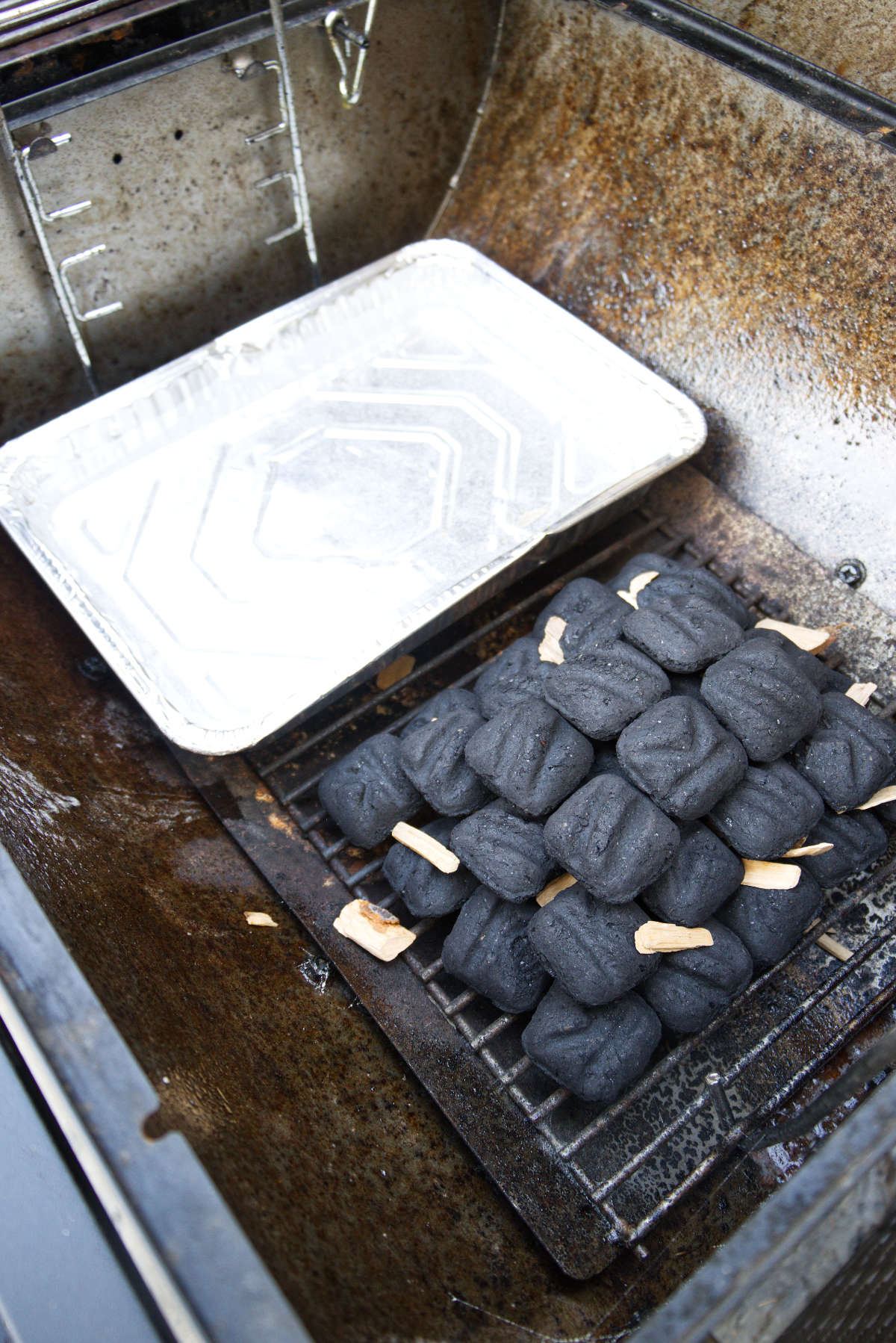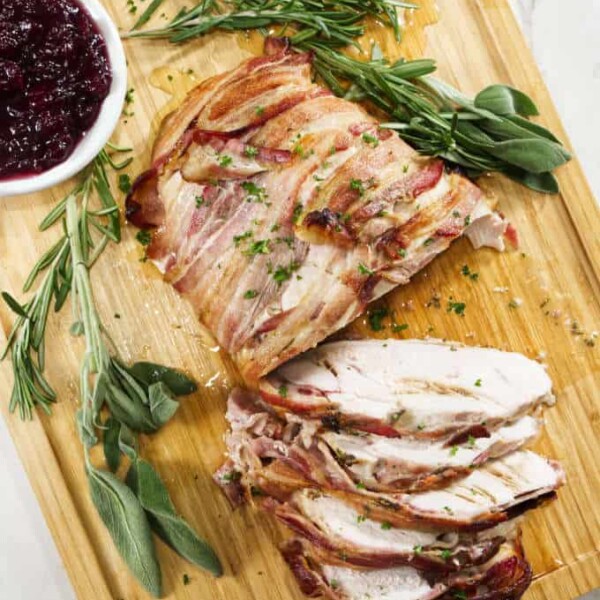How to Smoke a Pork Loin on a Charcoal Grill
on Jun 16, 2024, Updated Jul 01, 2024
This post may contain affiliate links. Please read our disclosure policy.
This guide for How to Smoke a Pork Loin on a Charcoal Grill will take your backyard BBQ to new heights! Sometimes, you just need to mix things up and pull out the reliable kettle grill, or maybe you just want that classic flavor from smoldering charcoal.
In this guide, we’ll walk you through everything you need to know to achieve that juicy, tender pork loin with three versatile smoking methods: the classic 2-zone method, the efficient burn-down method, and the low-maintenance snake method. Check out our other recipe if you are smoking boneless pork loin on the Traeger. Get ready and fire up that charcoal grill. Let’s get started!

🔥 Overview of Smoking Methods
There are three common methods of smoking boneless pork loin low-and-slow on a charcoal grill. Each one comes with its own advantages. How you smoke pork loin on a charcoal grill really comes down to preference, so I recommend testing each method. All of these methods can be used with a water pan to introduce more moisture and regulate the temperature. Alright, enough chit-chat. How ’bout we get into it?!
2-Zone Method
The 2-zone method involves creating two separate piles of charcoal on either side of the grill. Toss a pan of water in between the two piles to help keep things moist. Light some charcoal, and once it is ready, toss a couple of smoldering coals on top of each pile. Place your meat in the middle between each pile over the water pan. The pile will slowly burn, igniting the charcoal below. If you have a long smoking session, you can add more fresh charcoal on top of each pile to keep things burning. Place

Advantages
- Control: Offers precise control over cooking temperatures by allowing you to move the meat between the hot and cool zones of the grill.
- Versatility: Suitable for a wide range of foods beyond pork loin, including steaks and vegetables.
Cons
- Management: Requires more attention and management to maintain consistent temperatures. Can easily get too hot and may not be ideal for low-and-slow cooking.
- Fuel Consumption: Can consume more charcoal compared to other methods.
Burn Down Method
The burn-down method is similar to the 2-zone method. This time, just create a single stack of charcoal on the grill. Alongside the pile, you can add a water pan. Light some charcoal in your chimney and then spread a few pieces on top of the pile. As the charcoal burns down, it provides a consistent heat source. Again, place the meat over the water pan so that you are cooking over indirect heat.

Advantages
- Consistency: Provides a steady, consistent temperature for long smoking sessions.
- Ease of Use: Simple setup and minimal adjustments needed during the cook.
Cons
- Initial Heat: The initial temperature can be quite high, requiring careful monitoring.
- Fuel Efficiency: May use more charcoal at the start, potentially increasing overall fuel consumption.
Snake Method
The snake method is one of the more popular methods. It involves arranging charcoal briquettes around the perimeter of the grill in a long, curved line resembling a snake, with wood chips placed on top. Light some charcoal in your chimney, then place a couple of coals on one end of the snake and let it slowly burn its way around the grill, providing a low and steady heat for hours.

Advantages
- Longevity: Excellent for long, slow cooks, maintaining a stable temperature for several hours without adding more charcoal.
- Efficiency: Uses less charcoal over time and doesn’t require as much monitoring.
Cons
- Setup Time: Takes a bit more time to set up initially.
- Temperature Control: Requires careful arrangement to ensure an even burn and consistent temperature.
👨🍳 Smoking Hot Tips
How to smoke pork loin on a charcoal grill is all about patience and setting yourself up for success. Below are some key points to keep in mind during your smoking sesh.
- Keep Things Moist: Use a water pan on the grill alongside the charcoal. This will keep things moist and also help to keep the temperatures in the grill regulated. I use a disposable cake pan, but you can use any cake or loaf pan.
- Make It Smoky: Add some chunks of wood to the charcoal to get some delicious smoke flavor in your meat. Distribute a handful of pieces of wood throughout the charcoal so that you have wood burning throughout the entire smoking session.
- Take It Easy: Whatever method you use to smoke on a charcoal grill, start things off with just a couple of lit coals. We don’t want the piles of charcoal to burn quickly, and placing 2-3 lit coals on top is plenty to start things off just right.
- Use a Meat Thermometer: Invest in a meat thermometer that can also monitor the temperature in the grill.
- Monitor the Heat: If things are getting too hot in the grill, use your tongs to adjust the coals. Remove some of the super hot coals and adjust the piles to reduce the temperature. If it isn’t getting hot enough, light some more coals in your chimney and throw a couple more coals onto the pile.
- Prepare the Meat: If you have frozen pork loin, read more about how to thaw pork loin. Consider using a brine or marinade and use your favorite dry rub to help develop a beautiful crust on the outside of the pork loin.
💡 How to Light Charcoal
There are several methods to light charcoal. If you don’t have a chimney, go buy one now! It is by far the best way to develop some smoldering charcoal. Here is an overview to help set you up for success.
- Choose Your Charcoal: Pick up some high-quality lump charcoal or briquettes. Lump charcoal is easier to light, but it burns hotter and quicker. I usually use briquettes when smoking for a more consistent and slow burn. Either one will work well for smoking, so it comes down to preference.
- Arrange the Charcoal: For the parallel/2-zone method, make two piles of charcoal on either side of the grill with space for a water pan in the middle. For the burn-down method, make a single pile of charcoal on the grill, usually offset towards one side. For the snake method, arrange the charcoal in a long, curved line around the perimeter of the grill. Disperse some wood throughout the charcoal to help add smokiness.
- Use a Chimney Starter: Fill the chimney with a handful of charcoal and place a crumpled piece of newspaper or a fire starter cube under the chimney. Light the fire starter and let the charcoal ignite and burn for about 15-20 minutes. The charcoal is ready once it is covered in a light layer of ash.
- Add Lit Charcoal: For the 2-zone and burn-down methods, pile a few pieces of lit charcoal on top of the piles of the charcoal. For the snake method, add a couple of pieces of lit charcoal to the beginning of the snake.
- Monitor and Cook: Close the grill lid and adjust the air vents to control the temperature. Open the vents more to increase the temperature and close them slightly to lower the temperature. Allow the grill to preheat to 225°F to 250°F before placing your pork loin on the grill. Add more lit charcoal when needed in case the burn goes out, which is more common with the snake method. Adjust the charcoal and spread it out a bit if the temperatures get too high.

CONNECT WITH A LICENSE TO GRILL!
Be sure to follow us on our social media accounts.
Did you make this recipe? Tell us about it in the comments below!



